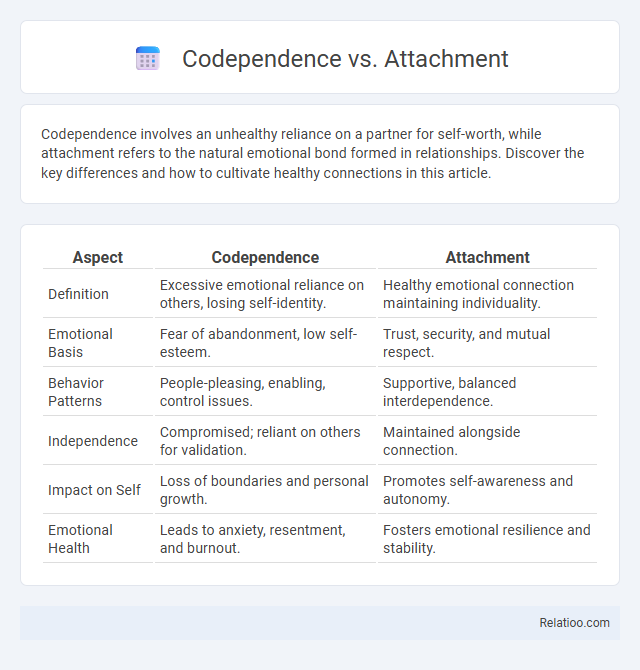Codependence involves an unhealthy reliance on a partner for self-worth, while attachment refers to the natural emotional bond formed in relationships. Discover the key differences and how to cultivate healthy connections in this article.
Table of Comparison
| Aspect | Codependence | Attachment |
|---|---|---|
| Definition | Excessive emotional reliance on others, losing self-identity. | Healthy emotional connection maintaining individuality. |
| Emotional Basis | Fear of abandonment, low self-esteem. | Trust, security, and mutual respect. |
| Behavior Patterns | People-pleasing, enabling, control issues. | Supportive, balanced interdependence. |
| Independence | Compromised; reliant on others for validation. | Maintained alongside connection. |
| Impact on Self | Loss of boundaries and personal growth. | Promotes self-awareness and autonomy. |
| Emotional Health | Leads to anxiety, resentment, and burnout. | Fosters emotional resilience and stability. |
Understanding Codependence: Definition and Features
Understanding codependence involves recognizing a dysfunctional relationship pattern where one person excessively relies on another for approval and identity. Unlike attachment, which is a natural emotional bond, codependence is characterized by an imbalanced dependence that compromises personal boundaries and self-worth. Your awareness of these features helps differentiate healthy attachments from codependent behaviors, promoting emotional autonomy and well-being.
Exploring Attachment: Types and Theories
Attachment theory identifies secure, anxious, avoidant, and disorganized attachment styles, each influencing how You form relationships and regulate emotions. Understanding these attachment types provides insight into behavioral patterns, distinguishing them from codependence, which involves excessive emotional reliance on others. Exploring Bowlby and Ainsworth's foundational work helps clarify the psychological mechanisms behind attachment and its impact on interpersonal dynamics.
Key Differences Between Codependence and Attachment
Codependence involves excessive emotional reliance on another person, often leading to unhealthy boundaries and enabling behaviors, while attachment refers to the natural emotional bonds formed for security and connection. You experience attachment as a healthy need for closeness, whereas codependence distorts this need into a compulsive and often one-sided dependency. Key differences include the level of control, with attachment fostering mutual support and codependence creating imbalance and loss of self-identity.
Psychological Origins of Codependence
Codependence stems from early emotional neglect or dysfunctional family dynamics, causing individuals to develop an excessive reliance on others for validation and self-worth. Unlike attachment, which is a natural emotional bond essential for healthy relationships, codependence involves a compulsive need to please and control, often sacrificing personal boundaries and well-being. Your understanding of these psychological origins is crucial for recognizing unhealthy patterns and fostering emotional independence.
The Science Behind Attachment Styles
Attachment styles are rooted in early relational experiences and influence how Your brain processes emotional bonds, differentiating healthy attachment from codependence. Neuroscientific studies reveal that secure attachment involves balanced oxytocin release and effective emotional regulation, while codependence correlates with maladaptive patterns such as heightened anxiety and diminished self-boundaries. Understanding these underlying mechanisms clarifies how attachment, codependence, and their psychological impacts manifest in Your interpersonal relationships.
How Codependence Impacts Relationships
Codependence profoundly affects relationships by fostering a dynamic where one person excessively relies on another for emotional support and self-worth, often leading to imbalance and resentment. Unlike healthy attachment, which allows for mutual dependency and independence, codependence blurs boundaries and hinders personal growth. This dysfunction can result in enabling negative behaviors, decreased communication, and emotional exhaustion within intimate partnerships.
Healthy vs. Unhealthy Attachment Patterns
Healthy attachment patterns foster secure connections where Your emotional needs are balanced with independence, promoting mutual respect and trust. Unhealthy attachment, often seen in codependence, involves excessive reliance on others for approval and identity, leading to imbalanced relationships and emotional distress. Recognizing these differences helps you develop supportive bonds that encourage autonomy while maintaining closeness.
Signs You May Be Experiencing Codependence
Signs you may be experiencing codependence include an excessive need for approval, difficulty setting boundaries, and prioritizing others' needs over your own well-being. Persistent feelings of guilt or anxiety when not helping others and an over-involvement in another person's problems are common indicators. Recognizing these signs is crucial for differentiating codependence from healthy attachment or casual emotional reliance.
Developing Secure Attachment: Strategies and Tips
Developing secure attachment involves fostering healthy emotional boundaries and self-awareness to counteract codependence, which often entails excessive reliance on others for validation. Strategies include practicing open communication, setting clear personal limits, and engaging in self-reflection to understand and regulate emotional needs effectively. Consistent application of these tips promotes balanced relationships and resilience against unhealthy attachment patterns.
Healing and Growth: Overcoming Codependence
Healing from codependence requires recognizing unhealthy attachment patterns where Your self-worth is tied to others' approval, leading to emotional imbalance. Developing boundaries and fostering self-awareness are essential steps for growth, enabling healthier relationships and emotional independence. Overcoming codependence involves consistent practice of self-care and seeking support through therapy or support groups focused on restoring personal autonomy.

Infographic: Codependence vs Attachment
 relatioo.com
relatioo.com